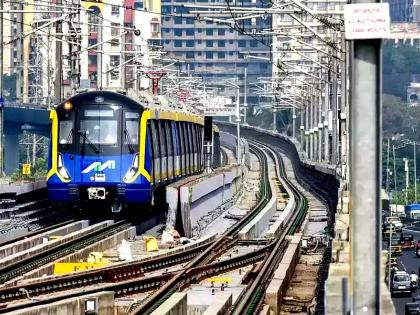Mumbai Metro Line 2B Nears Launch: What You Need to Know About the Yellow Line
By Lokmat English Desk | Updated: August 3, 2025 19:16 IST2025-08-03T19:16:04+5:302025-08-03T19:16:37+5:30
Mumbai’s metro network is on the verge of a major expansion with the upcoming Metro Line 2B, also known as ...

Mumbai Metro Line 2B Nears Launch: What You Need to Know About the Yellow Line
Mumbai’s metro network is on the verge of a major expansion with the upcoming Metro Line 2B, also known as the Yellow Line, stretching from D. N. Nagar in Andheri to Mandale in Mankhurd. Covering 23.64 km, this fully elevated corridor will feature 20 stations, connecting key residential and commercial hubs across the city. The route passes through crucial points such as Bandra, Kurla, Chembur, and Mankhurd, easing east-west connectivity. With an estimated project cost of ₹10,986 crore, the line is expected to transform commuting patterns for lakhs of Mumbai residents once operational in the coming years.
Construction Progress and Phase-Wise Plans
Work on Metro Line 2B has advanced considerably, with overall civil progress between 78% and 83% as of mid-2025. Specific construction milestones include 98% completion of pile caps, 92% of pier works, and nearly 87% of girder installations. The Mandale depot, a key facility spanning 31 hectares, is already 98% finished. Trial runs began in April 2025 on Phase 1, which covers a 5.4 km stretch from Mandale to Diamond Garden across five stations. Authorities aim to open this section to the public by the end of 2025, while full commissioning of the line is expected to be gradual between 2026 and 2027.
Train Features, Depot, and Capacity
Metro Line 2B will operate modern six-coach trains manufactured by BEML, designed with advanced features such as regenerative braking, onboard CCTV cameras, and mobile charging points. These trains will be stabled at the Mandale depot, which is built to accommodate up to 72 rakes. Out of the 96 trains sanctioned through international financial aid from ADB and NDB, 60 have already been delivered for deployment across various lines. With a daily ridership projection of over 10 lakh passengers by 2031, the line is expected to significantly decongest city roads and offer faster, safer, and more comfortable travel for commuters.
Time Savings, Connectivity, and Interchanges
Metro Line 2B will substantially cut travel time across eastern and western suburbs, reducing journeys by 50–75% depending on road traffic conditions. Commuters could save 15–20 minutes on short local routes alone. The corridor has been designed with multiple interchange stations, ensuring smooth connections with existing and upcoming lines. Key links include Line 1 at D. N. Nagar, Line 2A, Line 3 via Bandra, Line 4 at Kurla East, Line 7 at Chembur, and suburban railways at Kurla and Mankhurd. Additional connectivity with the monorail and future Metro 8A, as well as the Airport Rail Link, will create a robust multi-modal transport hub.
Why Metro Line 2B Matters for Mumbai
Beyond cutting travel time, Metro Line 2B is poised to reshape mobility for professionals and daily travelers in Mumbai. The corridor will enable seamless east–west transit, benefiting officegoers traveling between Andheri, Bandra-Kurla Complex (BKC), Chembur, and Mankhurd. With direct integration to suburban railways, highways, and other metro lines, it will promote a shift from private vehicles to public transport, easing traffic congestion and lowering pollution levels. The line’s wide network of interchanges and connectivity nodes strengthens access to commercial, residential, and industrial zones, making it one of the most crucial infrastructure projects for Mumbai’s future urban growth.